What can a chat bot do?
First, we identified the main office processes. We did not even talk about the chat bot. Here, for example, the order of business trips. Now I have to write to the employee of the business travel service in the mail: “I am going on a business trip to Surgut on the 5th for three days,” and he: “Is such and such a plane and such and such a hotel everything?”, And I: “ Yes, let's do". Then he will go to coordinate with the management, book the tickets himself, after some time he will send me confirmation that everything is OK. The bot can do the same thing.
Or if you need help for a visa, then the bot will knock on the bus, the bus will knock on the personnel subsystem and pick up the PDF, then send it to the HR department printer and write a letter that you need to print there. Then he will notify me that you can come in a couple of hours. If you need to issue a pass for a guest or book a meeting room for a meeting, then it is enough to entrust the bot with this task, and he will complete it.
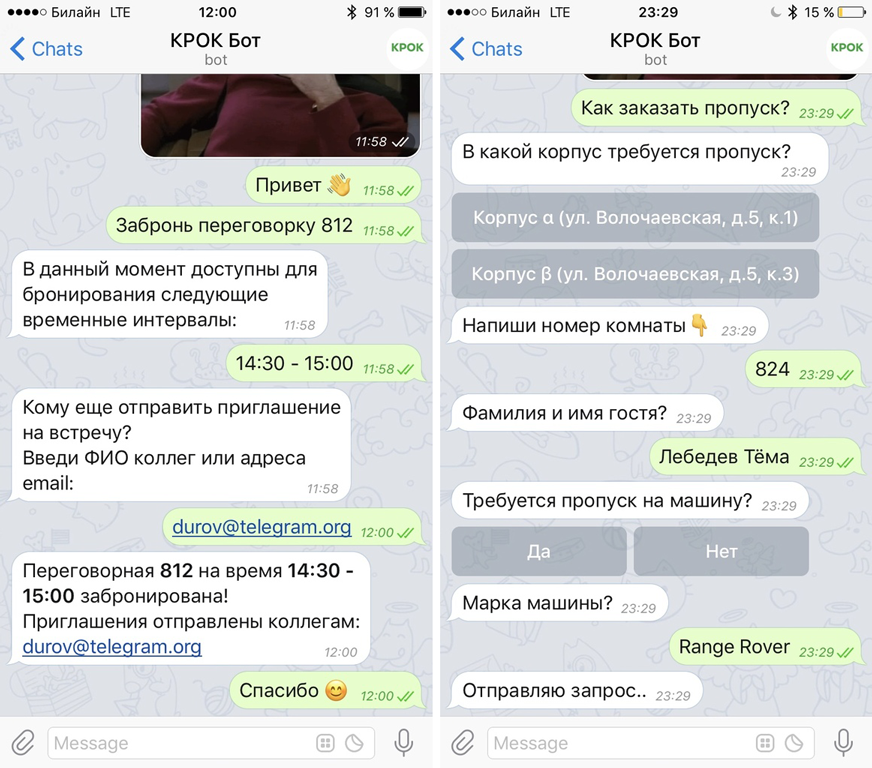
Now let's show an example a little more complicated.

In 3 weeks:
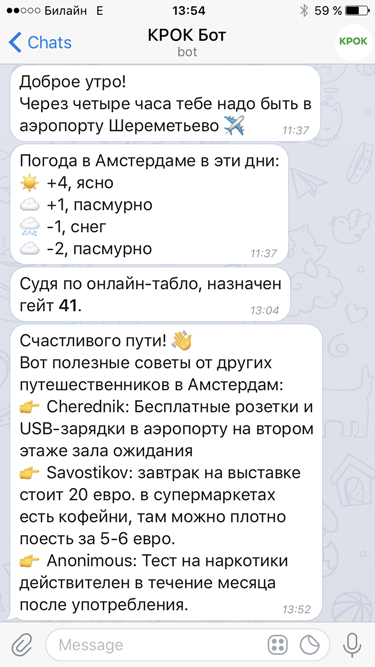
Our business trip dialogue uses a typical business process. The employee (his F.I.O. is in the authentication data) indicates the city of the trip and the date. The bot writes a ticket to the accounting department and a letter to the specialist responsible for purchasing tickets and booking travel. When the ticket is closed, the bot receives its result and further processes it using a script. The specialist processes the bot with letters or messages in the Telegram until it issues documents with tickets and reservations. He then searches for a user by the Wi-Fi hotspot in the office to determine the nearest available printer. Sends documents to print. On the day of departure, it reminds you of the trip, takes the weather from one of the external sites using its open API, then starts to poll the airport's online scoreboard for the schedule for the flight (the flight itself is on the ticket). After the trip, he will ask for a report on accounting tools (he will send a form and tell you how to fill it out), plus he will ask for useful tips for the knowledge base. In addition, he can order a taxi to the airport, order a car on the spot and pick up data on trips in order to make the amounts immediately to the advance report.
As you can see, each step is quite simple, but together they create a little magic. The only moment is a lot of fuss with documents, various exceptions and entering the systems that are not yet ready for such a digital transformation. A lot of functionality is in beta, alpha or just at the integration stage so far - development and testing take a very long time in working with documents so that a woodpecker accidentally flies does not bring down the entire office. But everything looks quite simple and logical.
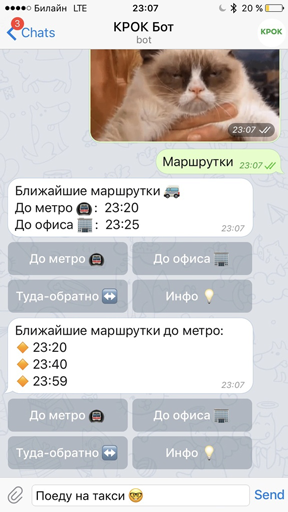
Conversation
Bots can learn from user syntax. Here is a simple example of how the Help Desk call through the bot looks like:
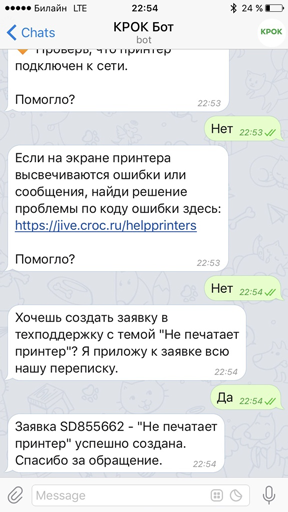
And this is a screenshot of the application in ITSM:
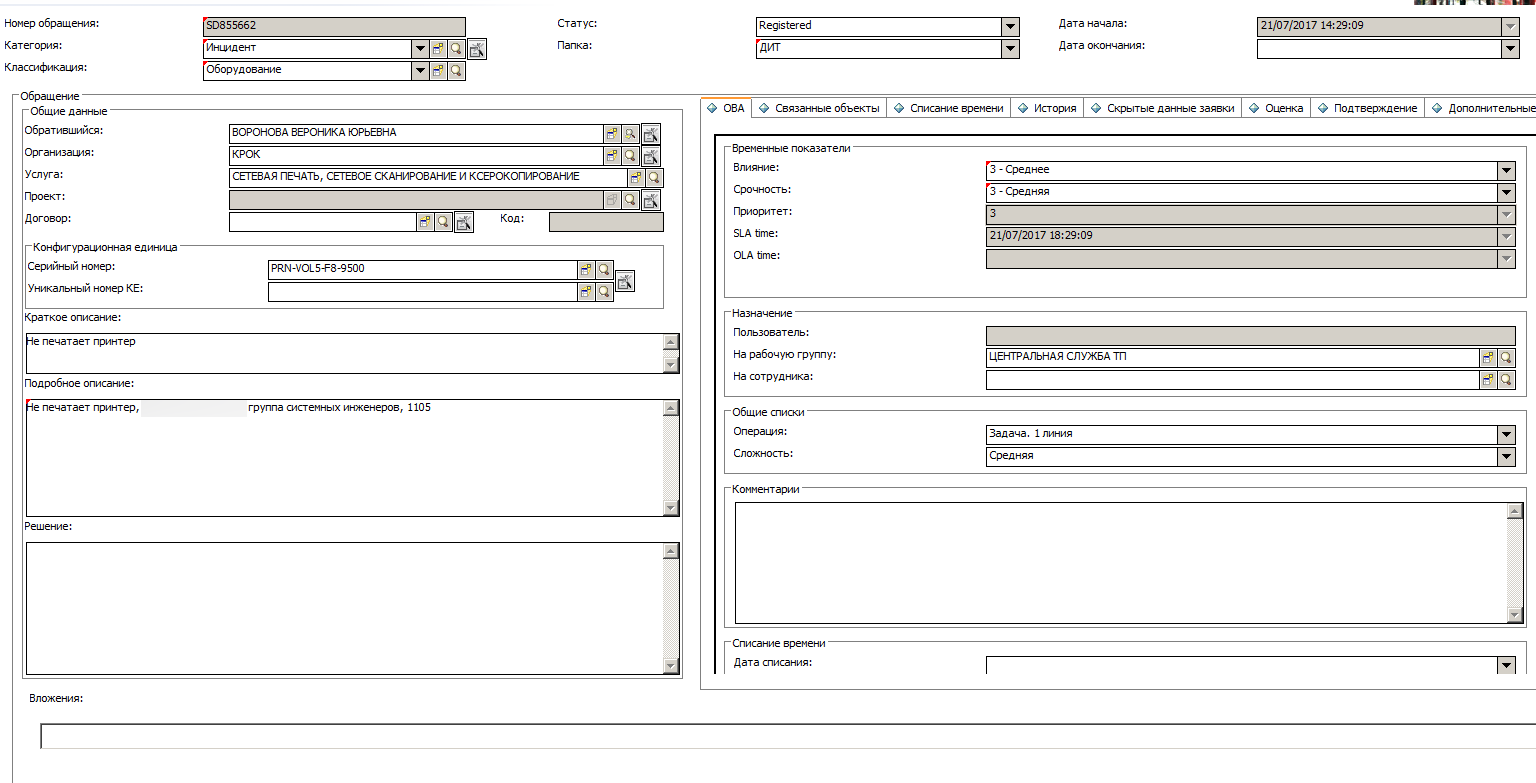
The process now is this: the user sends a more or less structured ticket, and then the helpdesk employee breaks it into type and subtype, after which the term of the incident is assigned and responsible. Next, you need to specify the type of appeal - the incident. Service - printing devices. The employee is Voronova. Responsible - Petrov. Office - 1105.
Over the years, quite a few pairs of free-form verbal queries and correctly completed forms of the ITSM system have accumulated. Then everything is simple: a little machine learning on this sample, and then the bot sends the type and subtype of the application to the system along with the user ticket. Naturally, he may be mistaken, so the process has changed slightly so far - the helpdesk employee simply receives the fields that are already filled in (in 80% of cases correctly filled), but, of course, can change their values.
The administrator can also use the bot in his work, for example, for this:

IVR systems are the same chatbots with a slightly changed interface. When connecting synthesis and voice recognition systems ( here such , there are also examples of dialogs), you can get the same chat in voice form. Many users like it very much, and now part of the office automation functions works through IVR. This will be especially true for those customers where users are not very familiar with computers.
We showed the bot at the exhibition, and the idea of tight integration with the office bus already went to customers. For example, one of them wants to launch telegram messages to coordinate server reboots. The idea is this: a request is coordinated by a number of people, when a mass of “okay” answers is gathered, the server reboots. In general, this is quite realistic. In the same way, document posting can be done. But this is already a very distant future.
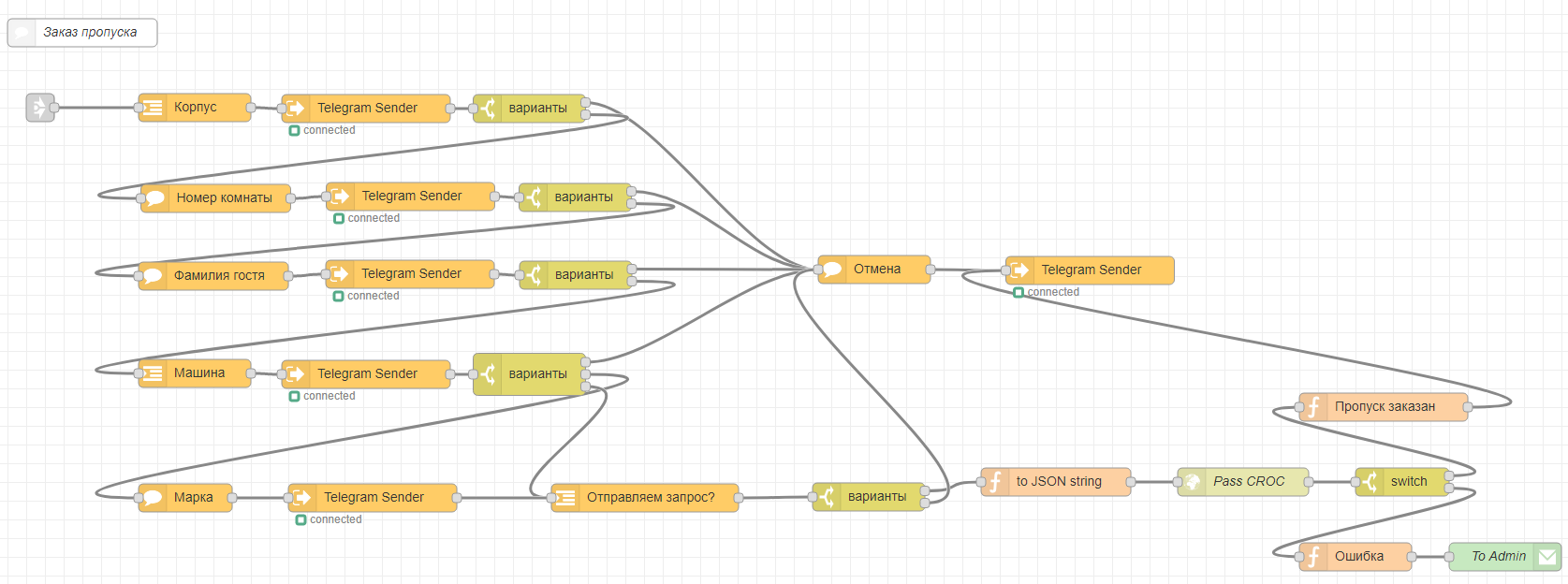
For example, a chatbot, a person or IVR is a data interface, a user task is “order a conversation at 15:00”. Connector - an authorization link. The bus performs the task.
Another completely banal example of how the bot works is the restoration of the account. Users (and there are about two thousand people in the office) regularly forget their passwords. Either they activate accounts on several devices - a phone, a tablet, a workstation ... And then either forgot to update the password somewhere, or the tablet simply stayed home and the child locked the account. In general, the moment of changing the password is a headache both for the employees themselves and for the technical support that they often call (especially in the mornings). Now the bot helps to reset the password, or rather, the unlock account. Moreover, the operation is absolutely routine.
Address Book Search:
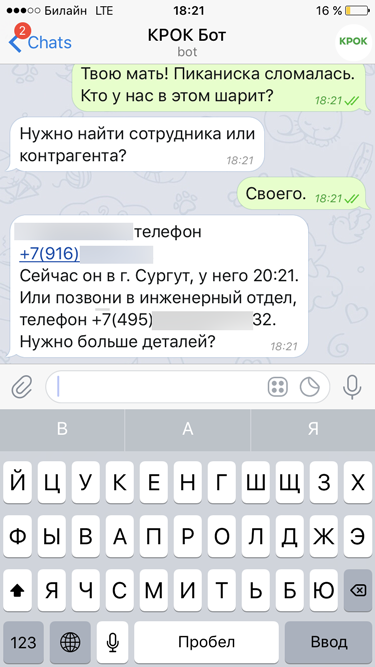
Here is a complex analysis of the query phrase to search for a contact within the company. Next is a request to the inside of the HR service, where we carefully rewritten all the useful skills of people in case of new projects and urgent calls. "Pikaniska" is a rather rare word, so a search on it is very relevant and no refinement is required. The bot unloads the data of the employee who understands the issue. If he was online, then you could immediately write to him. He is offline, and judging by the documents of the same personnel department - on a business trip to Surgut. The bot checks its time zone and provides data.
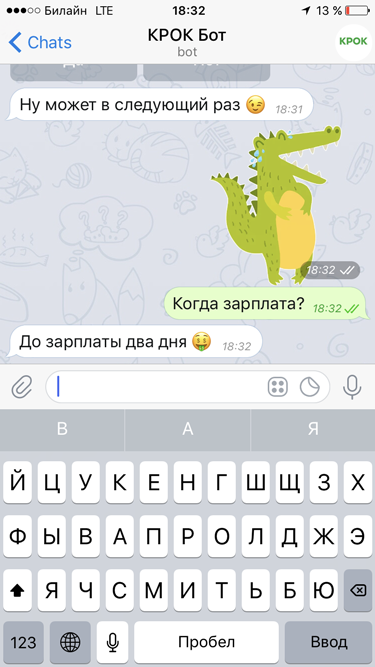
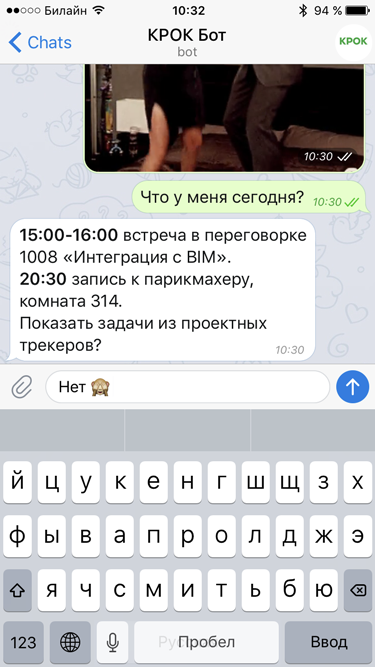
Here, too, everything is relatively simple. You can say to Bot that “remind me of lunch with Ivanov,” and he will set this task to remind you in time. The remaining data is available on the bus.
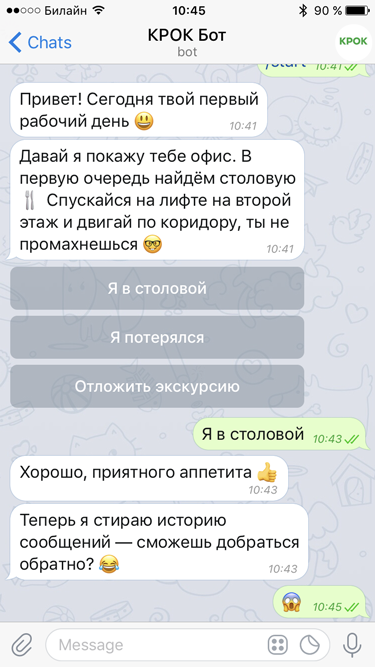
It all started with the idea of finding out what digital transformation, digitalization, etc. are, or there is a lot of noise on the market, but there is no specifics. In order to understand what it is, we decided to start with ourselves and understand what can be “digitalized” in our company. During the “digging topic”, we worked out a bunch of cases for digitalization, found solutions, but at the same time we were haunted by the idea of a “right” interface for office business processes. We didn’t even talk about the chat bot, in principle it was not even discussed. At some point, we realized that the approach to interacting with office business processes also needs to be changed, everything should be convenient and always mobile, and since 100 mobile applications cannot be done, it became clear that the future is with natural interfaces, in particular chat rooms. In particular, there is an incredible Chinese example of WeChat - originally an analog of ICQ,
More bots can tell basic things from the corporate training knowledge base, search for training materials, show the next internal courses and seminars, play the list of newcomers with newcomers (“Got my stationery”, “Found my kitchen”, “Checked in at the gym” and so on) , book a rest room or queue for the game console in the same place, get a password for guest Wi-Fi, find out the number of VHI, outpatient clinics, an ambulance phone, tell the office medical service about the injury, make an appointment with the office medical service, book a simulator, report sweat lost or found things (the bot then connects people or flips the log to the secretary), send corporate news, give different information to new employees, how to live, warn about the birthdays of your contacts. In the long-term plans is to check the length of the queue in the dining room using video analytics (usually from 1 to 15 minutes, now it is implemented by a separate informer in our office), find out the menu for today in the dining room or order pizza in the office, find travel companions, transfer documents. The technical service plans include replacing the corporate SIM card, changing the tariff, accepting bug reports for any things like “the lamp is off on the fifth floor”, sending the bug report to the household service or cleaning staff.
Of course, the main stumbling block for all customers with this approach to digital transformation of the office is the security (authorization) of users, and the second is the place where all this correspondence is stored. In the case of our bot, correspondence is stored in the CROC cloud, on the bot server, that is, in our internal infrastructure. All integration between the bot and company systems goes through a single integration bus. Connection to the bus - through a universal connector that allows you to divide access rights into three parts: public parts (public), for all employees and for certain employees.
About authorization, the story is long and rich in adventure, so if you're interested, I’ll tell you separately. Well, and if you have questions not for comments, write: digital@croc.ru.
Or if you need help for a visa, then the bot will knock on the bus, the bus will knock on the personnel subsystem and pick up the PDF, then send it to the HR department printer and write a letter that you need to print there. Then he will notify me that you can come in a couple of hours. If you need to issue a pass for a guest or book a meeting room for a meeting, then it is enough to entrust the bot with this task, and he will complete it.

Now let's show an example a little more complicated.

In 3 weeks:

Our business trip dialogue uses a typical business process. The employee (his F.I.O. is in the authentication data) indicates the city of the trip and the date. The bot writes a ticket to the accounting department and a letter to the specialist responsible for purchasing tickets and booking travel. When the ticket is closed, the bot receives its result and further processes it using a script. The specialist processes the bot with letters or messages in the Telegram until it issues documents with tickets and reservations. He then searches for a user by the Wi-Fi hotspot in the office to determine the nearest available printer. Sends documents to print. On the day of departure, it reminds you of the trip, takes the weather from one of the external sites using its open API, then starts to poll the airport's online scoreboard for the schedule for the flight (the flight itself is on the ticket). After the trip, he will ask for a report on accounting tools (he will send a form and tell you how to fill it out), plus he will ask for useful tips for the knowledge base. In addition, he can order a taxi to the airport, order a car on the spot and pick up data on trips in order to make the amounts immediately to the advance report.
As you can see, each step is quite simple, but together they create a little magic. The only moment is a lot of fuss with documents, various exceptions and entering the systems that are not yet ready for such a digital transformation. A lot of functionality is in beta, alpha or just at the integration stage so far - development and testing take a very long time in working with documents so that a woodpecker accidentally flies does not bring down the entire office. But everything looks quite simple and logical.

Some more magic
Conversation
Bots can learn from user syntax. Here is a simple example of how the Help Desk call through the bot looks like:

And this is a screenshot of the application in ITSM:

The process now is this: the user sends a more or less structured ticket, and then the helpdesk employee breaks it into type and subtype, after which the term of the incident is assigned and responsible. Next, you need to specify the type of appeal - the incident. Service - printing devices. The employee is Voronova. Responsible - Petrov. Office - 1105.
Over the years, quite a few pairs of free-form verbal queries and correctly completed forms of the ITSM system have accumulated. Then everything is simple: a little machine learning on this sample, and then the bot sends the type and subtype of the application to the system along with the user ticket. Naturally, he may be mistaken, so the process has changed slightly so far - the helpdesk employee simply receives the fields that are already filled in (in 80% of cases correctly filled), but, of course, can change their values.
The administrator can also use the bot in his work, for example, for this:

Vote
IVR systems are the same chatbots with a slightly changed interface. When connecting synthesis and voice recognition systems ( here such , there are also examples of dialogs), you can get the same chat in voice form. Many users like it very much, and now part of the office automation functions works through IVR. This will be especially true for those customers where users are not very familiar with computers.
Integration with any processes for many users
We showed the bot at the exhibition, and the idea of tight integration with the office bus already went to customers. For example, one of them wants to launch telegram messages to coordinate server reboots. The idea is this: a request is coordinated by a number of people, when a mass of “okay” answers is gathered, the server reboots. In general, this is quite realistic. In the same way, document posting can be done. But this is already a very distant future.

For example, a chatbot, a person or IVR is a data interface, a user task is “order a conversation at 15:00”. Connector - an authorization link. The bus performs the task.
More features
Another completely banal example of how the bot works is the restoration of the account. Users (and there are about two thousand people in the office) regularly forget their passwords. Either they activate accounts on several devices - a phone, a tablet, a workstation ... And then either forgot to update the password somewhere, or the tablet simply stayed home and the child locked the account. In general, the moment of changing the password is a headache both for the employees themselves and for the technical support that they often call (especially in the mornings). Now the bot helps to reset the password, or rather, the unlock account. Moreover, the operation is absolutely routine.
Address Book Search:

Here is a complex analysis of the query phrase to search for a contact within the company. Next is a request to the inside of the HR service, where we carefully rewritten all the useful skills of people in case of new projects and urgent calls. "Pikaniska" is a rather rare word, so a search on it is very relevant and no refinement is required. The bot unloads the data of the employee who understands the issue. If he was online, then you could immediately write to him. He is offline, and judging by the documents of the same personnel department - on a business trip to Surgut. The bot checks its time zone and provides data.


Here, too, everything is relatively simple. You can say to Bot that “remind me of lunch with Ivanov,” and he will set this task to remind you in time. The remaining data is available on the bus.

How it all began
It all started with the idea of finding out what digital transformation, digitalization, etc. are, or there is a lot of noise on the market, but there is no specifics. In order to understand what it is, we decided to start with ourselves and understand what can be “digitalized” in our company. During the “digging topic”, we worked out a bunch of cases for digitalization, found solutions, but at the same time we were haunted by the idea of a “right” interface for office business processes. We didn’t even talk about the chat bot, in principle it was not even discussed. At some point, we realized that the approach to interacting with office business processes also needs to be changed, everything should be convenient and always mobile, and since 100 mobile applications cannot be done, it became clear that the future is with natural interfaces, in particular chat rooms. In particular, there is an incredible Chinese example of WeChat - originally an analog of ICQ,
More bots can tell basic things from the corporate training knowledge base, search for training materials, show the next internal courses and seminars, play the list of newcomers with newcomers (“Got my stationery”, “Found my kitchen”, “Checked in at the gym” and so on) , book a rest room or queue for the game console in the same place, get a password for guest Wi-Fi, find out the number of VHI, outpatient clinics, an ambulance phone, tell the office medical service about the injury, make an appointment with the office medical service, book a simulator, report sweat lost or found things (the bot then connects people or flips the log to the secretary), send corporate news, give different information to new employees, how to live, warn about the birthdays of your contacts. In the long-term plans is to check the length of the queue in the dining room using video analytics (usually from 1 to 15 minutes, now it is implemented by a separate informer in our office), find out the menu for today in the dining room or order pizza in the office, find travel companions, transfer documents. The technical service plans include replacing the corporate SIM card, changing the tariff, accepting bug reports for any things like “the lamp is off on the fifth floor”, sending the bug report to the household service or cleaning staff.
Of course, the main stumbling block for all customers with this approach to digital transformation of the office is the security (authorization) of users, and the second is the place where all this correspondence is stored. In the case of our bot, correspondence is stored in the CROC cloud, on the bot server, that is, in our internal infrastructure. All integration between the bot and company systems goes through a single integration bus. Connection to the bus - through a universal connector that allows you to divide access rights into three parts: public parts (public), for all employees and for certain employees.
About authorization, the story is long and rich in adventure, so if you're interested, I’ll tell you separately. Well, and if you have questions not for comments, write: digital@croc.ru.
